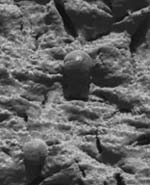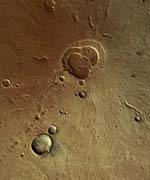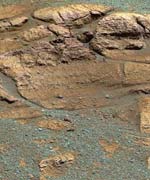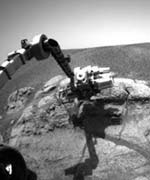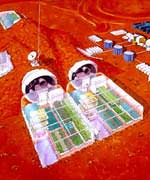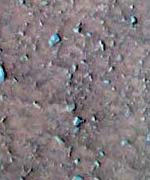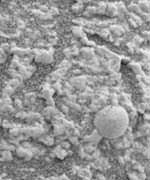
Image credit: NASA/JPL
During Tuesday’s NASA mission briefing on progress with the rover at Meridiani Planum, Mars Exploration Rover (MER) principal invesigator, Steve Squyres introduced not just startling new water evidence, but another new piece to the bigger astrobiological puzzle: water and sulfur. “With this quantity of sulfate [up to forty percent sulfur salts at some places near the Opportunity landing site], you kind of have to have water involved.”
But water is just the first puzzle piece in any future biological picture for the red planet, according to mission scientists. This sentiment was underscored by considering just a few of the puzzle pieces still missing. Time for instance is one element yet to be considered. “We know that the essential major and minor biogenic elements exist on Mars,” wrote Rocco Mancinelli , a SETI Institute scientist, “The primary factor in determining if life could have arisen on Mars lies in determining if liquid water existed on its surface for sufficient time. The history of water lies within the mineralogy of the rocks.”
Habitability and Energy
But now that some local portions of Mars show mineralogical promise of just such water at least temporarily ‘soaked’ into their geological record, what other key ingredients might be needed next, particularly to have supported a convincing case for ancient habitability? The tough question begs for a comparison to what microbiologists know about life on Earth, so one must begin with a simpler experiment: How would a hardy Earth microbe survive today on Mars?
Not particularly well, according to most microbiologists. The compound problems of low temperatures, low pressures, and scarce energy are multifold on today’s Mars, even when ‘today’ is taken to include the last tens of millions of years in Mars’ meteorological history.
Compared to the Earth’s average temperature of 15 C (59 F), Mars globally has an average temperature of -53 C (-63.4 F). While transient temperatures do occasionally rise above water’s freezing point in the equatorial regions around both landing sites, most biological scenarios need a booster shot of basic warmth. A habitable case for the red planet usually posits a long-lost Mars–one that was both wetter and warmer than what might seem hostile to even the hardiest lifeforms known today.
The Next Generation of Better Microbes, Desulfotomaculum
But once a water source is identified, perhaps the bigger immediate problem on Mars is the very thin and unbreathable atmosphere, one that is a mere one percent of Earth’s sea level pressure. If exposed on the surface, a microbe on Mars today would quickly dessicate and freeze. That is, unless it could pull off some kind of hibernation once the environment turned extreme to its favored biology. A promising microbial candidate must evolve some means to sporulate, as it would prove a big plus to hibernate during long periods whenever Martian weather turned inhospitable.
Scientists intrigued by ancient–and so far, local– water evidence uncovered near the Opportunity site have posed the speculative question: would spore-forming, sulfate-reducing bacteria offer a new model organism for the next generation of Mars’ microbe hunters?
According to one veteran Viking and MER science team member, Benton Clark, one such candidate has been a leading contender for weathering the harsh martian conditions that could otherwise fatally stress a microbe. Clark, of Lockheed Martin in Denver, said “I’ve always had a favorite organism, Desulfotomaculum, which is an organism that can live off sulfate, as we find in these rocks.”
Since 1965, when the spore-former was first discovered and classified, its biology has offered some of the best extremes for microbial survivability. Living without sunlight while forming spores when the weather gets cold or dry could make this hardy organism a model to consider among future planetary scientists.
Primitive Solar Energy Independence
Loosely, the name Desulfotomaculum means a ‘sausage’ that reduces sulfur compounds. It is a rod-shaped organism; the Latin, -tomaculum, means ‘sausage’. Desulfotomaculum is an anaerobe, meaning it does not require oxygen. Terrestrially, it is found in soil, water, and geothermal regions, and in the intestines of insects and animal rumens. Its lifecycle depends on reducing sulfur compounds like magnesium sulfate (or epsom salts) to hydrogen sulfide.
The sulfur-metabolizing microbes use a very primitive form of energy generation: their chemical action is as important as their immediate habitat. From what we know about conditions on the early Earth, it was probably hot, and there was a lot of ultraviolet (UV). It was a reducing atmosphere, so things like hydrogen sulfide as an inorganic source of energy are probably what was available to use. On Earth, some Desulfotomaculum species grow optimally at 30-37 C but can grow at other temperatures depending on which of the nearly 20 species of Desulfotomaculum is being cultured.
On the frigid, dry planet so far from the Sun, anything that metabolizes successfully would also benefit from some novel pathways other than photosynthesis to produce energy. Surprisingly while certain kinds of radiation hazards on Mars can be treacherous, the lack of UV sunlight itself is an immediate problem. What kind and intensity of sunlight might be most useful to common green or chlorophyll-rich life on Earth? Or when might a microbe thrive only with helpful shade from soil coverage or a dark rocky overhang. Doing without direct sunlight might be a Martian norm.
“[Desulfotomaculum] needs some hydrogen to go with that, but [sulfur] is its energy source. It can work independent of the sun,” said Clark. “The reason I like the latter organism is because it can form spores as well, so it can hibernate over these interim times on Mars between the warmer spells and the differences in [solar] obliquity that we know about.”
“So in addition to physical evidence of fossils,” said Clark, “you can have chemical evidence. It turns out that sulfur is one of those tracers that work out quite well in isotopic fractionation. When living organisms process sulfur, they tend to fractionate isotopes differently from geological or mineralogical ways…So there are organisms and isotopic ways to look for it. To do the isotopic analysis, you’re probably going to have the samples back on Earth.”
Preserving Life
MIT geologist, John Grotzinger, took up the challenging question of how a future mission planner might begin to formulate an overall biological strategy. After successfully landing near this kind of outcrop at the Opportunity site, can a future Mars’ mission look for evidence of fossil life? “The answer to this question is very simple. On Earth, which is the only experience that we have, finding fossils preserved in ancient rocks is very rare. You have to do everything you can to optimize the situation for their preservation.”
From the outset of the Opportunity mission, Andrew Knoll, a Harvard paleontologist and member of the MER science team told Astrobiology Magazine that, “The real question that one wants to keep in mind when thinking about Meridiani is: What, if any, signatures of that biology actually get preserved in diagenetically stable rocks? ..If water is present on the Martian surface for 100 years every 10 million years, that’s not very interesting for biology. If it’s present for 10 million years, that’s very interesting.”
“You worry first about preservation,” emphasized Grotzinger. “You target your strategy to optimize preservation. If something was there, these [conditions can be] ideal for time capsules…but it is something of a challenge. …We want to urge caution in interpreting these results at this point.”
“Stay tuned,” concluded Squyres.
Original Source: NASA/Astrobiology Magazine

